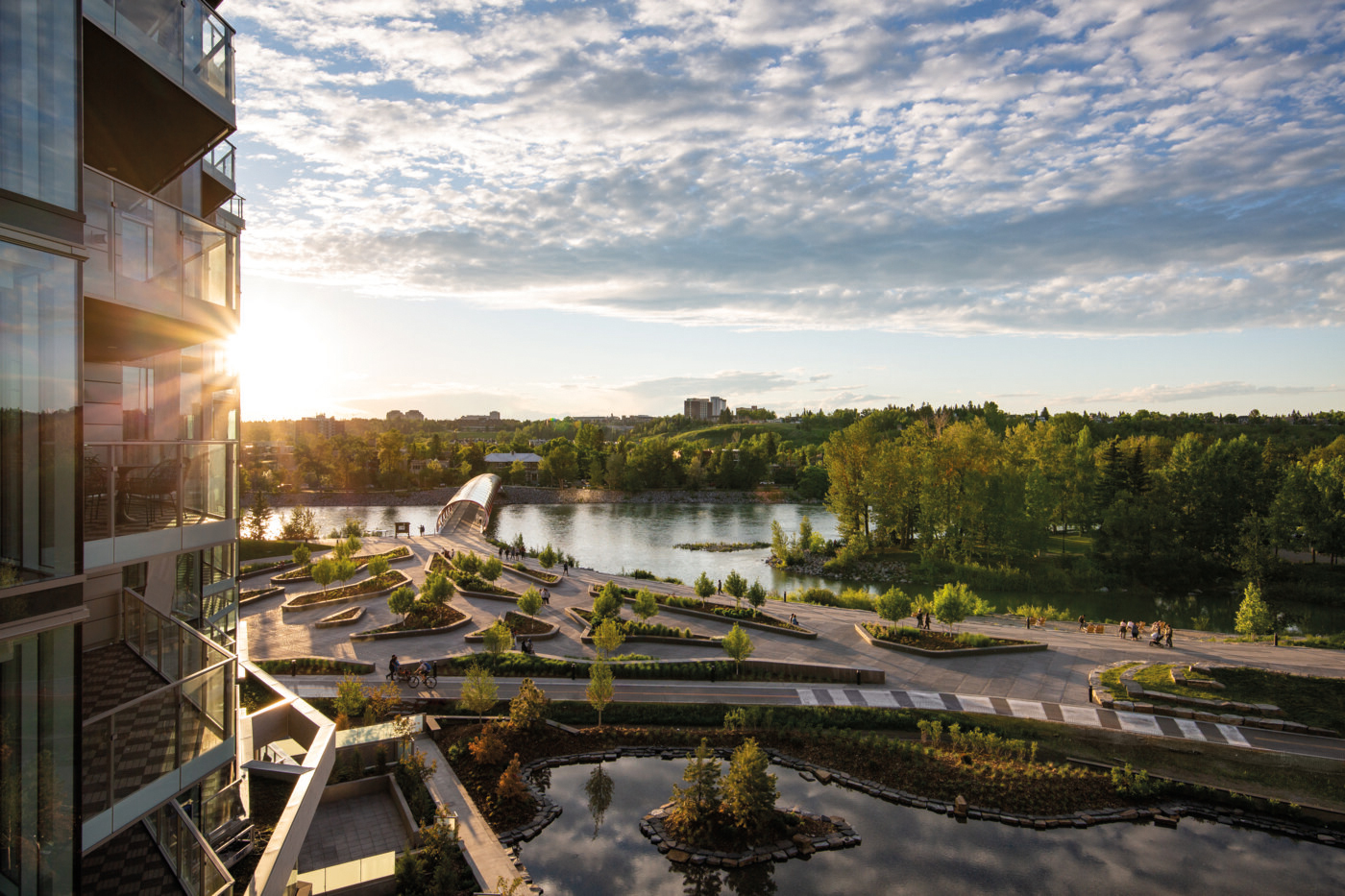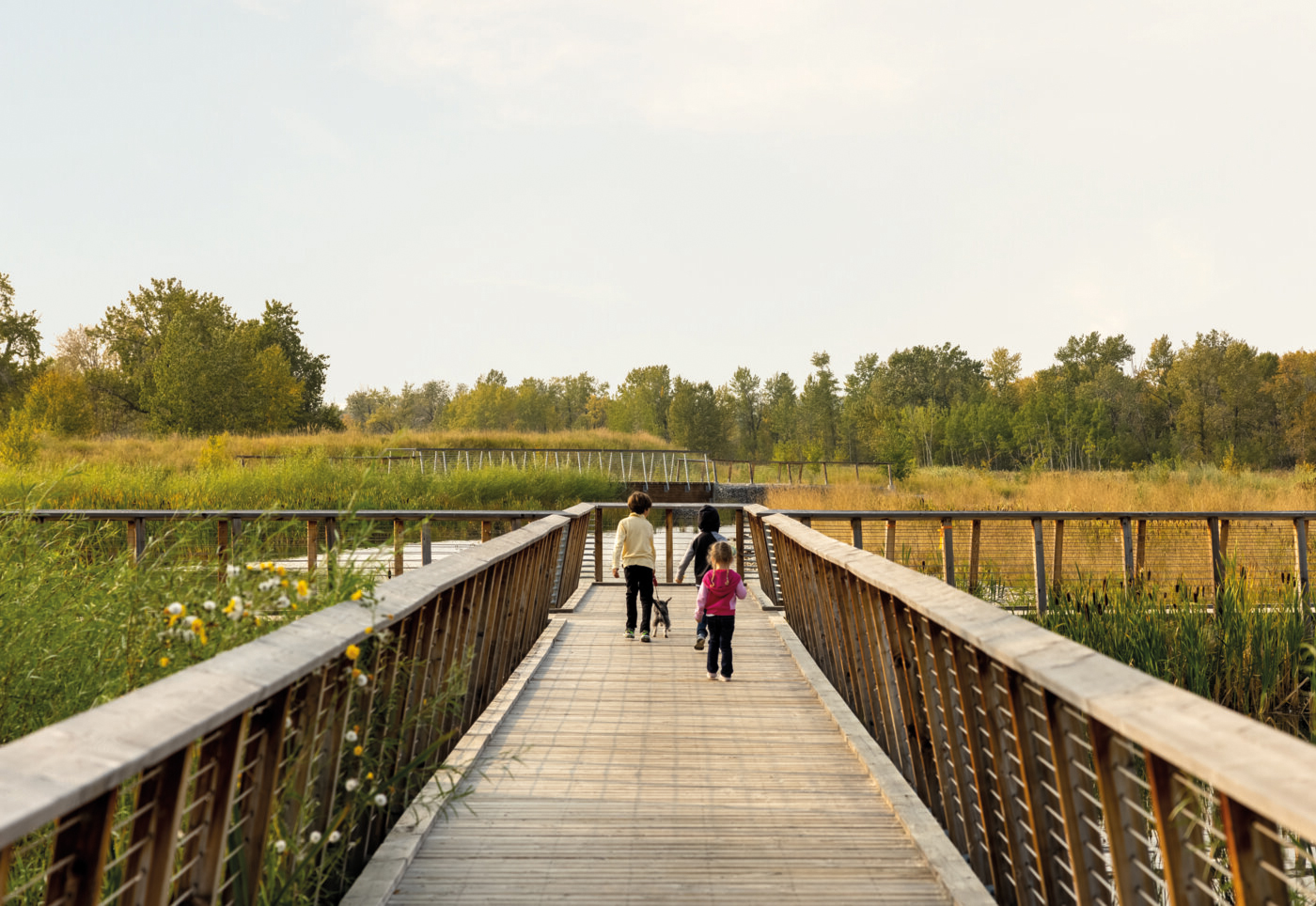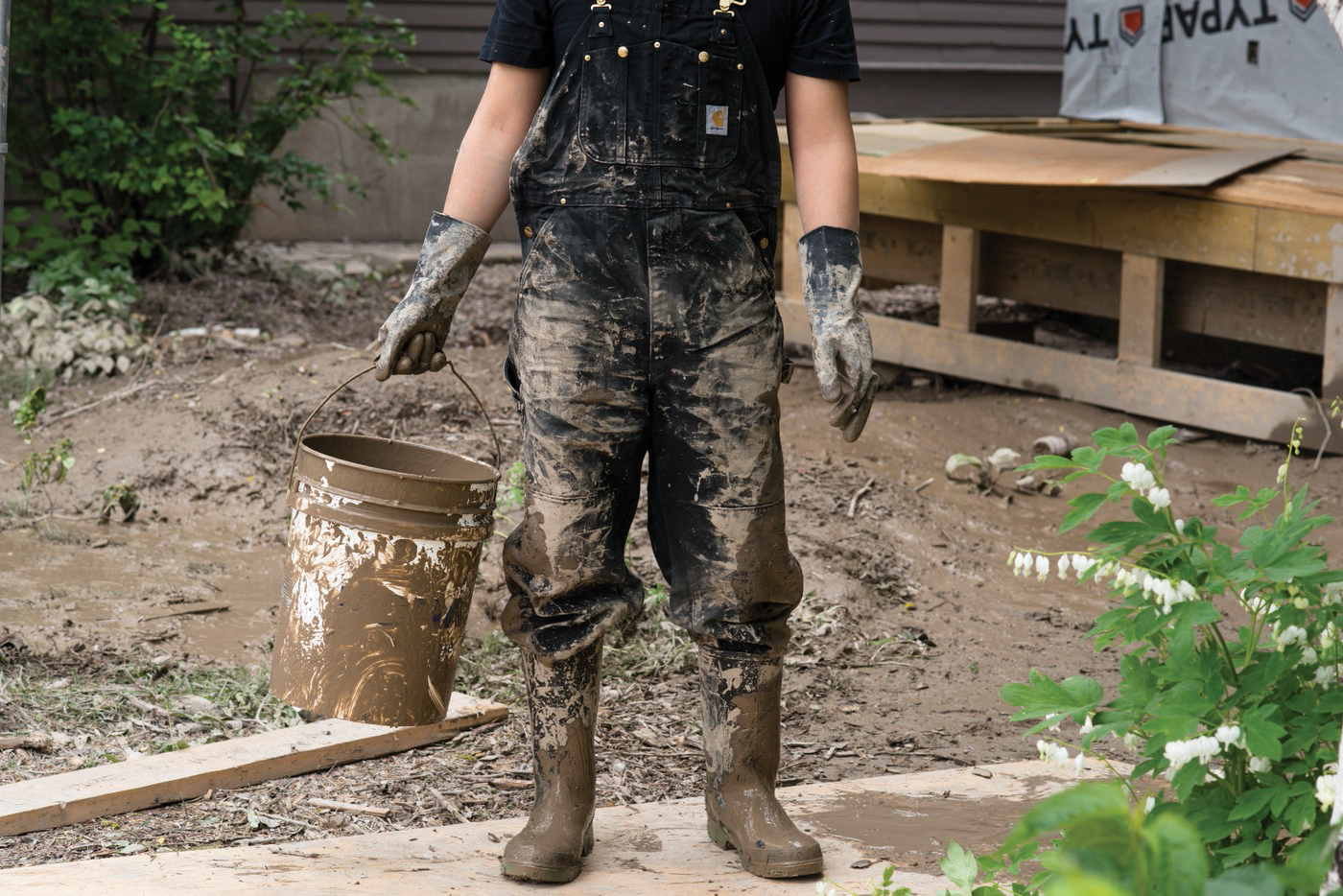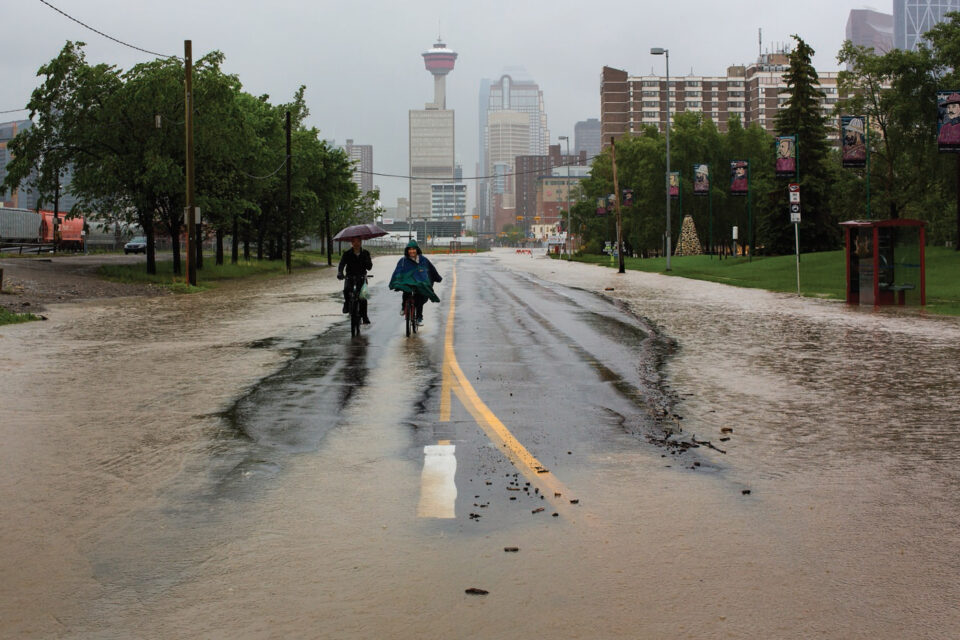The water came so fast on June 20, 2013, that the man in charge of monitoring the flow for the City of Calgary wasn’t sure he could believe what he was seeing. Before long, he truly couldn’t believe what he was seeing because so much of the monitoring infrastructure — from gauges to radar — was damaged by the flood itself.
Frank Frigo, a hydrologist and now the manager of environmental management for the City of Calgary, says, at one point, they were sending staff out with cellphones to monitor the gauges and relay rising water levels. “There were several points where the sheer awe at the power of nature made it difficult to accept that what we were seeing was, in fact, occurring,” Frigo says.
Much of the city was also in awe and disbelief: streets, houses and commercial buildings flooded; events were cancelled; entire neighbourhoods, including downtown, were evacuated; one person died; and it’s estimated over $6 billion worth of property and infrastructure was damaged in southern Alberta. Calgarians from across the city rushed into the worst affected areas, muddying boots and rolling up their sleeves to help fill sandbags, and then to help clean up.
Now, 10 years on, a period that has been overseen by six premiers, three provincial governments under three different parties and two mayors; and has had countless public staff turnovers; the lesson of just how quickly things can change has stuck.
A Look Back
For three days in June 2013, the sky opened up, drenching Calgary and surrounding areas with around 250 millimetres of precipitation in the hardest hit areas, a deluge that mixed with spring snowmelt from the Rockies to heave rivers in the Bow Valley five or six metres over their usual summer levels. Without much notice, the City scrambled to react, lowering the Glenmore Reservoir to its minimum level before the surge hit on the Elbow. On the Bow, reservoirs operated by TransAlta also emptied to make way for the coming flood waters.
Those actions prevented an even bigger disaster, but were not enough to contain the torrents. Water was soon roaring over the Glenmore Dam’s walls and swamping the downstream neighbourhoods. Soaked earth couldn’t absorb any more water. Overwhelmed sewers couldn’t handle the flow. One of the worst-hit communities was the inner-city neighbourhood of Sunnyside, just north of the Bow, which drowned in runoff from higher ground and backup from outdated sewers.
In all, the flood impacted 32 communities across Calgary. Homes were ruined. Lives were torn apart by stress. It’s estimated the losses within the city were $2 billion — including $409 million worth of City of Calgary infrastructure, earning it the title at the time of being Canada’s costliest natural disaster.
“[The flood] took out portions of the LRT, it took out major pieces of infrastructure, a number of bridges, it shut down major transportation networks, which not only complicated the recovery and response efforts, but also impacted the economy in far-reaching ways for not just days, but weeks and in some cases, months down the road,” says Frigo.
But, even then, in the midst of a rapid and chaotic response, there was remarkable collaboration, he says. City officials across departments gathered in the new Calgary Emergency Management Agency centre and were joined by representatives from utilities, including Telus, ATCO and Enmax in order to deal with a cascading set of crises and responses.
According to Daniel Henstra, a professor of political science at the University of Waterloo, who is researching governance of flood responses in Canada, the scale of it all created what’s known as a focusing event. “There’s a sense of urgency to do something about the problem, at least in the short period after a major event like this happens,” Henstra says.
The challenge then becomes maintaining that sense of urgency once the waters recede.

The Response
Henstra says one thing that stands out about the response is how the City realized the broad scope of the issue it was facing. This wasn’t one crisis, but a reminder of the city’s — and the region’s — complex relationship to water. As the climate crisis takes hold, that relationship is increasingly marked by unpredictability: flood and drought.
Not only was the City looking long-term, it also brought together a diverse group of experts — sociologists, engineers, designers and others — to form the Expert Management Panel and advise the City on how best to tackle the issues. “What works in terms of the stickiness around the focus on flooding, is if you can create an institutional structure that keeps it on the agenda,” Henstra says.
The Expert Management Panel’s recommendations formed the backbone of the City’s Flood Resilience Plan, which established guiding principles and measurable milestones in order to track progress as the years ticked by and attention spans wavered. It also established a holistic view of the water the city uses and attempts to control.
“What our senior leadership did and our politicians did, was after the flood, they realized that ‘flood’ is an issue that is bigger than just ‘flood,’ in a lot of ways,” Frigo says. “It is about total water management.” Flooding, drought, safety, environmental impacts, social impacts, recreation, history, drinking water supply and quality, and regional collaboration: all of those factors came to bear on the City’s response to the floods.
Centred around the confluence of the Bow and the Elbow, Calgary’s relationship to these rivers has been key to its identity since its inception, and well before that when First Nations gathered here. The Bow and Elbow Rivers are rich with culture and are important to Calgarians, who see them as important aesthetic and recreational assets.
Today, rafters dot the waters during hot summer days, while tourists come from around the world to fly fish in the Bow. The banks of both rivers are lined with pathways and parks that are some of the most cherished public spaces in the city.
Frigo says a big part of the success of the response is due to public engagement. The City reached out to groups and individuals, but it was also held to task by determined locals including the Calgary River Communities Action Group (CRCAG). “Having that consistent voice, knowing that elected folks can sometimes focus just on the term in front of them rather than the long term, we think was really critical,” says Tony Morris, who serves as co-president of the group alongside Brenda Leeds Binder.
CRCAG worked hard to ensure the Springbank off-stream reservoir, a key barrier for the Elbow, moved ahead, despite changing political whims and fierce opposition. It also pushed back against regulations the Province wanted to bring in for homeowners rebuilding after the flood, and focused on the critical but often overlooked process of developing land-use bylaws. “One thing we’ve always said is that we don’t want that policy to undo the good work of good infrastructure, and bad policy can absolutely do that,” Morris says.

Where We Stand
There are some big-ticket items in Calgary’s water management and flood protection. The Springbank Off-Stream Reservoir is being built west of the city to divert and hold water in the event of flooding. The Government of Alberta is investing a total of $744 million into the construction of the Springbank Off-Stream Reservoir, while the Government of Canada contributed $168.5 million to the project.
There are also defences that moonlight as great place-making initiatives. Examples include the tree-lined Eau Claire pathways near the Peace Bridge, which include a flood wall being built to protect downtown, and the unique Dale Hodges Park, a public art project that doubles as a stormwater treatment area.
There are also all of the unsexy bits and pieces that fit into the larger whole, such as storm sewer upgrades and the agreement between the Province and TransAlta to manage the company dams, not just for power, but for drinking water and flooding, as well.
Frigo, in addition to having his improved monitoring, can now also access an extensive database that shows the economic impacts of different flood levels in order to measure costs, benefits and outcomes. It’s what allows him the precision to say the flood risk has diminished by 54 per cent — a figure that will climb to 70 per cent once the Springbank Reservoir is complete.
“The entire City of Calgary water group is very proactive and forward-looking,” says Kim Sturgess, PhD, the CEO of environmental consulting company WaterSMART. “So, when it comes to the things they needed to do, quite a few of them are done.”
That’s not to say the work is complete. More dams on the Bow River upstream of Calgary are in the exploratory phase and are likely years from construction. Morris and Leeds Binder are still working hard to ensure the Springbank off-stream reservoir moves forward and on schedule. There’s also a lot of work to do on natural infrastructure that maintains a healthy environment, clean water and helps with flood and drought, says Sturgess.
And there are more policy pieces that need to be in place before some decisions are made and some impacts known. Updated flood maps from the Province are expected this year and that could have repercussions for where, and how, the City builds into the future. A berm slated for Bowness is on hold while other options along the Bow are explored.
The Calgary Factor
Henstra says one of the difficulties in studying cities is that “when you look at various factors that could be considered as determinants of certain behaviours, it often comes down to one or two people who are just particularly astute, are champions of something, who are able to not only have the technical knowledge, but also the capacity to sell it to decision-makers.” It could also come down to something as basic as a solitary City worker who’s particularly adept at writing grants. For flood mitigation, that could mean the difference between a riverfront walkway, a dirt berm or a giant gap in a city’s armour.
In Calgary, there were — and are — people like Frigo, who, 10 years on, still talks excitedly about flood mitigation and how far the city has come. There’s the Calgary River Communities team, still working to ensure governments don’t get distracted, despite the fact Morris swore it wouldn’t become his retirement project (it has).
The crisis formed collaborative bonds that have lasted, thanks to that continued energy. They’re needed as the City and the Province continue to think about how we manage river basins as a whole, in the face of a changing climate.
Frigo and his team have more time to prepare for a coming flood thanks to improved forecasting and monitoring. There is now an emergency response plan in place that considers everything from the Calgarians sleeping rough by the rivers to community evacuations and bridge closures.
“We realized that, in the same way that the Bow and Elbow River catchments that provide the water to Calgary are so much bigger than the municipal jurisdiction of Calgary itself, the solutions need to be much bigger than just the geographic landscape or the political and social landscape of the local municipality,” Frigo says.
His department now has the tools it needs; sewers have been upgraded; flood walls, a dry dam, berms and more have been constructed from the outskirts of the city right to its core. There has even been some room for beauty, integrating flood mitigation with public spaces along the river’s edge. But the real story of how the region responded, and how it now manages its water, has more to do with those neighbours rushing in to help than it does any of the bricks, mortar, earth, bits, bytes and radars that reduce the city’s flood risk.
It’s about collaboration. And it’s about people.
“I can tell you that many of the relationships internally that I built in responding to the flood remain important to carrying on the work that we’ve done since then, in terms of recovery and resilience,” Frigo says. “I’m happy to say we’re in a really, really different place today.”

Flood of Progress
The City of Calgary’s Flood Resilience Plan includes three areas of work: upstream flood protection, community level protection and property level protection. In addition to building and partnership planning, better monitoring and updated emergency response plans also help protect the city against flooding in the future. These are some of the building projects at various stages of completion for flood mitigation.
Glenmore Dam Gates (complete): New 2.5-m-high steel gates on the dam double the reservoir’s storage capacity.
Springbank Reservoir (under construction): When complete, this reservoir, combined with the extra capacity at Glenmore, would protect Elbow River communities from flooding at the level seen in 2013.
Bow River Reservoir Options: The Province is currently assessing three options for a reservoir on the Bow.
Ghost Lake Reservoir Operations Agreement: The Province and TransAlta have an agreement to keep the Ghost Lake Reservoir levels low during flood season in order to help control the river’s flow.
Permanent Flood Barriers: Barriers in Downtown, West Eau Claire, Hillhurst-Sunnyside, Inglewood, Bowness, Heritage Drive and the Bonnybrook Water Treatment Plant are in various states of completion.
Sunnyside Stormwater Lift Stations (complete): Pump Station #1 has a new lift station and Pump Station #2 has been improved.
Sanitary Lift Stations (complete): Both the Sunnyside and Roxboro sanitary lift stations have been completed.
[Note: Due to an editing error, an earlier version of this story had incorrect information about the budget of the Springbank Off-Stream Reservoir. We have updated the story to reflect the accurate contributions from both the provincial and federal governments.]

